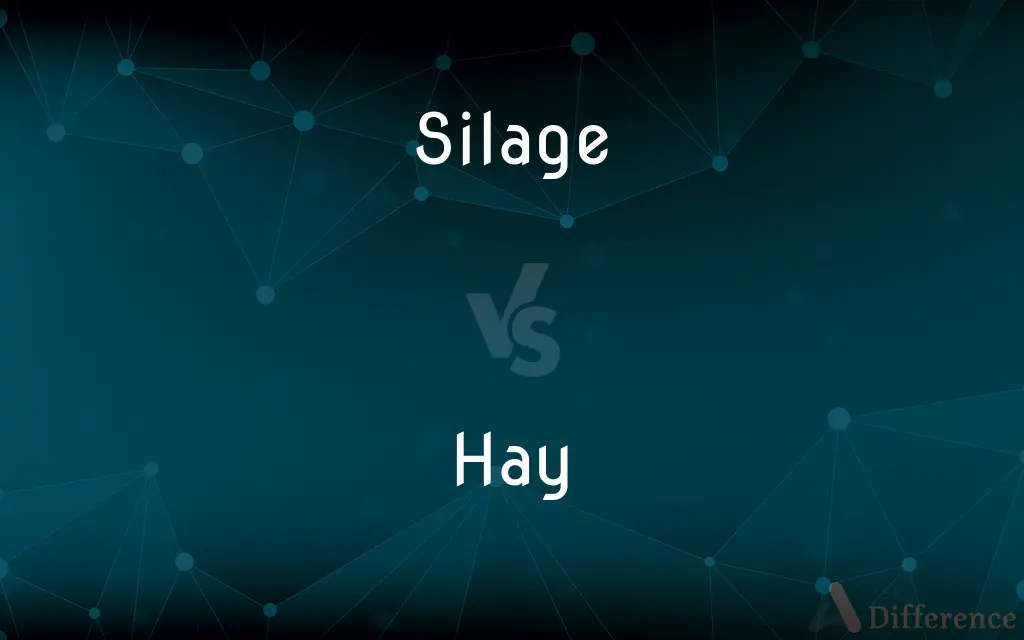Silage vs. Hay — What's the Difference?
Edited by Tayyaba Rehman — By Fiza Rafique — Updated on March 26, 2024
Silage is fermented, high-moisture stored fodder which can feed animals year-round, offering high nutritional value. Hay, in contrast, is dry grass or plants cut and stored for animal feed, with lower moisture content, typically used in drier conditions.

Difference Between Silage and Hay
Table of Contents
ADVERTISEMENT
Key Differences
Silage involves the fermentation of green foliage crops, which are cut and stored in an anaerobic environment, such as a silo, to preserve the majority of their nutrients and moisture. This process results in a high-moisture feed, rich in vitamins and can be fed to livestock throughout the year, making it particularly valuable in regions with long winters or dry seasons. Whereas hay consists of grasses or legumes that have been cut, dried to reduce moisture content to prevent spoilage, and then stored. The drying process concentrates the feed's nutrients but can result in some loss of nutritional value compared to silage.
The preparation of silage is more labor-intensive and requires specific conditions for successful fermentation, including an airtight environment to promote the growth of desirable bacteria while preventing spoilage. On the other hand, making hay is a simpler process that mainly involves cutting, drying, and baling the plants. Hay can be stored in a variety of environments as long as it remains dry and is protected from the elements.
Silage's high moisture content (usually between 40-60%) supports a lactic acid fermentation process, which preserves the feed and can improve digestibility and palatability for livestock. Conversely, hay typically has a moisture content of less than 20%, which minimizes the risk of microbial growth and spoilage but does not undergo fermentation, making its nutritional quality depend more heavily on the timing of cutting and the drying process.
Storage requirements also differ significantly between the two. Silage needs to be kept in an anaerobic environment to maintain its quality and prevent spoilage, such as a silo, plastic wrap, or a covered pit. Hay, however, requires protection from rain and moisture to prevent mold and rot, often stored in barns or under coverings.
In terms of nutritional value, silage generally offers more consistent quality and a higher moisture content, which can be beneficial for certain types of livestock and in certain climates. Hay, while potentially lower in some nutrients due to the drying process, is more versatile and easier to handle, store, and transport, making it a staple feed for a wide range of animals.
ADVERTISEMENT
Comparison Chart
Moisture Content
High (40-60%)
Low (<20%)
Process
Fermentation in an anaerobic environment
Drying in the sun
Storage
Requires airtight environment
Needs protection from moisture
Nutritional Value
High, with preserved vitamins and nutrients
Moderate, some loss during drying
Preparation
Labor-intensive, specific conditions needed
Simpler, involves cutting and drying
Usage
Ideal for year-round feeding
Commonly used in drier conditions
Digestibility
Improved by fermentation
Depends on plant maturity and drying process
Palatability
Often higher due to fermentation
Can vary, often less than silage
Storage Requirements
Silo, plastic wrap, covered pit
Barns, under coverings
Risk of Spoilage
Low if stored properly
Higher if exposed to moisture
Compare with Definitions
Silage
The process of making silage is more complex than hay.
Ensuring the right moisture content in silage is critical.
Hay
Hay is easier to store and transport than silage.
Stacked hay bales were covered to protect them from rain.
Silage
Silage is fermented, high-moisture fodder stored to feed livestock.
The farmer stored corn silage to feed his cattle during winter.
Hay
The nutritional value of hay depends on the timing of cutting.
Early-cut hay has more nutrients than late-cut hay.
Silage
It requires an anaerobic environment for successful fermentation.
They used airtight silo bags for silage to ensure quality.
Hay
It has a low moisture content to prevent spoilage.
Properly dried hay prevents mold growth and maintains quality.
Silage
Silage is known for its high nutritional value and digestibility.
Dairy cows fed on silage produced more milk.
Hay
Hay is dried grass or legumes stored for animal feed.
They baled the hay under the hot sun to preserve its nutrients.
Silage
Silage can be made from a variety of crops, including grass, corn, and sorghum.
Sorghum silage is popular in drought-prone areas.
Hay
Hay is a staple feed for a variety of livestock.
The sheep thrived on a diet of mixed grass hay.
Silage
Silage () is a type of fodder made from green foliage crops which have been preserved by acidification, achieved through fermentation. It can be fed to cattle, sheep and other such ruminants (cud-chewing animals).
Hay
Hay is grass, legumes, or other herbaceous plants that have been cut and dried to be stored for use as animal fodder, particularly for large grazing animals raised as livestock, such as cattle, horses, goats, and sheep. However, it is also fed to smaller domesticated animals such as rabbits and guinea pigs.
Silage
Grass or other green fodder compacted and stored in airtight conditions, typically in a silo, without first being dried, and used as animal feed in the winter.
Hay
Grass or other plants, such as clover or alfalfa, cut and dried for fodder.
Silage
Make silage
They do 1500 acres of contract silaging each year
Hay
(Slang) A trifling amount of money
Gets $100 an hour, which isn't hay.
Silage
Fodder prepared by compressing and fermenting green forage crops under anaerobic conditions, usually in a silo.
Hay
To mow and cure grass and herbage for hay.
Silage
Fermented green forage fodder stored in an airtight silo or clamp.
Hay
To make hay on (a patch of land).
Silage
To ensile.
Hay
To make (grass or other plants) into hay.
Silage
Short for Ensilage.
Hay
To feed with hay.
Silage
Fodder harvested while green and kept succulent by partial fermentation as in a silo
Hay
(uncountable) Grass cut and dried for use as animal fodder.
Hay
(countable) Any mix of green leafy plants used for fodder.
Hay
(slang) Cannabis; marijuana.
Hay
A net set around the haunt of an animal, especially a rabbit.
Hay
(obsolete) A hedge.
Hay
(obsolete) A net placed around the lair or burrow of an animal.
Hay
(obsolete) An enclosure, haw.
Hay
(obsolete) A circular country dance.
Hay
The letter for the h sound in Pitman shorthand.
Hay
To cut grasses or herb plants for use as animal fodder.
Hay
To lay snares for rabbits.
Hay
A hedge.
Hay
A net set around the haunt of an animal, especially of a rabbit.
Hay
Grass cut and cured for fodder.
Make hay while the sun shines.
Hay may be dried too much as well as too little.
Hay
To lay snares for rabbits.
Hay
To cut and cure grass for hay.
Hay
Grass mowed and cured for use as fodder
Common Curiosities
What is the key difference between silage and hay?
The key difference is moisture content and processing: silage is fermented and has high moisture, whereas hay is dried.
How do you store silage to prevent spoilage?
Silage is stored in an anaerobic environment, such as a sealed silo, plastic wrap, or covered pit, to prevent spoilage.
Why is silage considered more nutritious than hay?
Silage preserves more nutrients and vitamins through the fermentation process, while hay loses some nutritional value during drying.
Is hay or silage better for animals in dry regions?
Hay is often preferred in dry regions due to its lower moisture content and easier storage.
Can all types of livestock eat silage?
Yes, most types of livestock can eat silage, but it is particularly beneficial for ruminants like cows and sheep.
How long can hay be stored?
If kept dry and protected from the elements, hay can be stored for several years without significant loss of quality.
What determines the quality of hay?
The quality of hay is largely determined by the timing of cutting, drying process, and storage conditions.
Is it more expensive to produce silage or hay?
Producing silage tends to be more expensive due to the need for specialized equipment and storage facilities.
Why is fermentation important for silage?
Fermentation preserves the feed, improves digestibility, and enhances palatability for livestock.
Can feeding silage to livestock affect milk taste?
Yes, the diet of dairy cows, including silage, can influence the taste and composition of the milk produced.
Can silage spoil if not stored properly?
Yes, silage can spoil if exposed to air or moisture, leading to loss of nutritional value and possible health risks for animals.
How does the fermentation process affect silage?
Fermentation converts sugars in the crop into acids, preserving the silage and preventing spoilage by undesirable microbes.
Share Your Discovery

Previous Comparison
Fund vs. Foundation
Next Comparison
Acidosis vs. AlkalosisAuthor Spotlight
Written by
Fiza RafiqueFiza Rafique is a skilled content writer at AskDifference.com, where she meticulously refines and enhances written pieces. Drawing from her vast editorial expertise, Fiza ensures clarity, accuracy, and precision in every article. Passionate about language, she continually seeks to elevate the quality of content for readers worldwide.
Edited by
Tayyaba RehmanTayyaba Rehman is a distinguished writer, currently serving as a primary contributor to askdifference.com. As a researcher in semantics and etymology, Tayyaba's passion for the complexity of languages and their distinctions has found a perfect home on the platform. Tayyaba delves into the intricacies of language, distinguishing between commonly confused words and phrases, thereby providing clarity for readers worldwide.














































